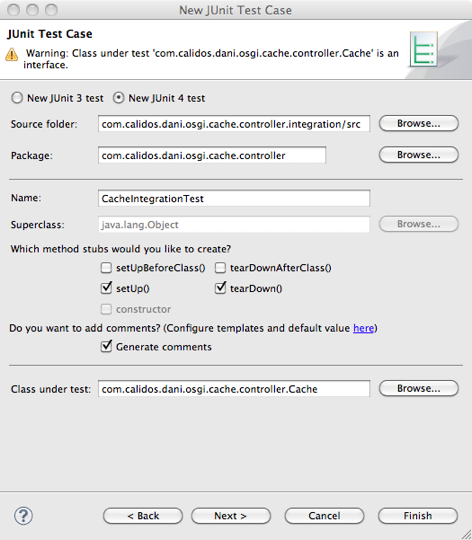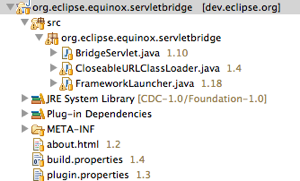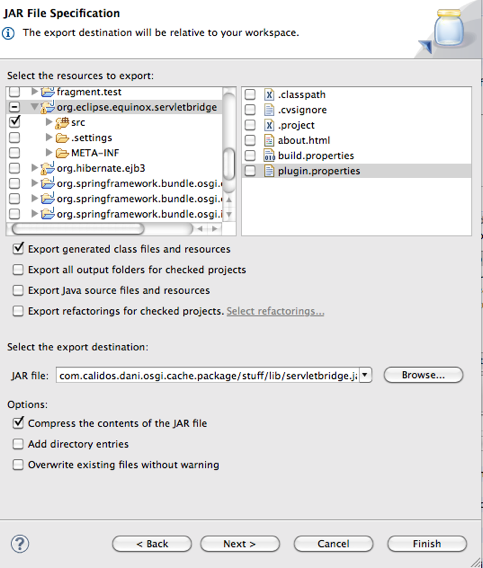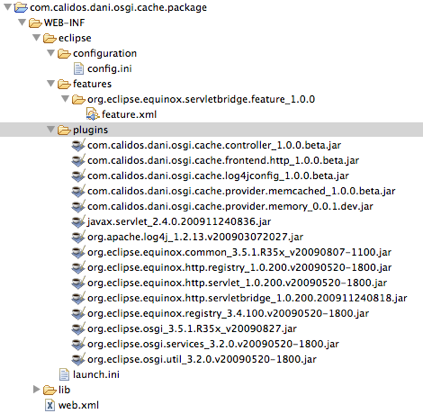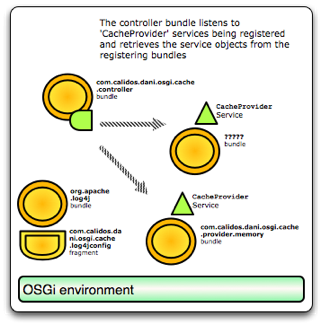After some well-deserved rest the OSGi components on the server series is back with a vengeance and a somewhat independent post. For some background please check the other posts in the series.
A common feature of Web applications is the need to output structured content, be it XML, XHTML markup, JSON or many others. A number of technologies is used to do that but few seem to be that dynamic, usually only reloading templates when they change or loading them from URLs. Surely we can leverage OSGi to make things more interesting…
Therefore we should be following the OSGi dynamic philosophy as much as possible, exploiting the features made available by the framework such as dynamic discovery, services, bundle headers and the lot.
In the case of our cache app we are violating quite a few basic design principles by having the format embedded in the java code. So we should as well use a template separate from the code and if possible reuse some existing well-known templating engine from somewhere.
Given these basic design principles let’s get started.
Firstly, we need a robust and flexible templating engine. We select the mature Freemarker engine which is reasonably speedy and has the power and flexibility we want. Make sure you check out the license, of course.
We could stop at putting the library JAR in a bundle and package it so it can be used by any other bundle and that is what we do to be able to use it in OSGi. That however doesn’t exploit many of the nicer OSGi capabilities so we will create another bundle called ‘com.calidos.dani.osgi.freemarker-loader’.
What we want is to allow bundles to carry templates inside them and have our freemarker-loader templating bundle discover them automagically. This is the same technique that the Spring dynamic modules use and you can find more info here. The mechanism is described in this diagram:

That is easy enough with a BundleTracker and a BundleTrackerCustomizer implementation. The BundleTracker class tracks bundles being added to the environment like this:
tracker = new BundleTracker(context, Bundle.RESOLVED, templateTracker); tracker.open();
With this snippet the tracker instance will look for bundles in the RESOLVED state (which lets us track fragments). The ‘templateTracker’ object is an instance of BundleTrackerCustomizer and will receive callbacks whenever bundles are added to the environment.
For instance, when a bundle is added we check for a special header in the bundle which tells us what is the relative path of available templates in the bundle being resolved:
public Object addingBundle(Bundle bundle, BundleEvent event) {
// we look for the header and act accordingly
String templatesLocation = (String) bundle.getHeaders().get(TEMPLATE_HEADER);
if (templatesLocation!=null) {
Enumeration bundleTemplates = bundle.findEntries(templatesLocation, "*.ftl", true);
HashSet templatesFromAddedBundle = new HashSet();
while (bundleTemplates.hasMoreElements()) {
URL templateURL = bundleTemplates.nextElement();
addTemplate(bundle, templateURL,templatesLocation);
templatesFromAddedBundle.add(templateURL);
}
templatesOfEachBundle.put(bundle.getBundleId(), templatesFromAddedBundle);
}
return null;
} // addingBundle
An interesting method being used here is ‘findEntries’ which loads all the entries in the provided templates folder and lets us add them to our holding structure. We also take care to implement the methods to remove the templates and update them accordingly whenever bundles are updated or unloaded from the environment.
Having TEMPLATE_HEADER with a value of ‘Freemarker-Templates’ means that bundles having a header such as Freemarker-Templates: /templates will have any templates within that folder (please note that the ‘/templates’ bit is not added to template URLs!).
The next thing we need to do is make the loaded templates available to the environment. To do that we make a freemarker Configuration object accessible as an OSGi service object. That Configuration instance is the main object Freemarker to load and use templates and has an interesting mechanism to override its template loading mechanism we use to make available our OSGi environment templates.
freemarkerConfig.setTemplateLoader( new URLTemplateLoader() {
@Override
protected URL getURL(String url) {
Stack templateStack = templates.get(url);
if (templateStack!=null) {
TemplateEntry templateStackTop = templateStack.peek();
if (templateStackTop!=null) {
return templateStackTop.getTemplateURL();
}
return null;
}
return null;
}
});
The service Configuration object is set with a template loader inner class that uses our template holding objects to retrieve templates stored in our OSGi context. Cool.
This also allows us to effectively disable the template refreshing cycles that Freemarker does by default (allegedly making it slightly more efficient). Now we only need to refresh a bundle containing the templates to get the new version. This can be modified by using the appropriate methods on the Configuration service of course. (There is another method explained later).
An interesting feature we can add to exploit the dynamic nature of OSGi is to make templates available in a stack. This means different bundles can dynamically overwrite templates by the same name. Moreover, once a template is removed the previous version becomes available. This can be used to make temporary changes to templates to add or remove diagnostics information, test new templates temporarily, etc.
We do that using a Stack of TemplateEntry objects, TemplateEntry being a helper class to store template entries.
This is all very nice but we have a problem when having multiple versions of the same bundle that hold multiple copies of the same template, this means they will stack and we have no way to access a particular version of a template. To solve this problem we store each template in three different stacks by three different URLs:
- ‘path/file.ftl’
- ‘bundle://bundlename/path/file.ftl’
- ‘bundle://bundlename:version/path/file.ftl’
In this manner we can use the more generic URL in most cases but still can access specific versions when needed. It is important to think about the dynamic nature of OSGi as well as the possibility of several versions of the same bundle coexisting peacefully in the same environment.
From the perspective of any bundle using the service in the simplest case it only needs to look for a service named ‘freemarker.template.Configuration’. For convenience, the property ‘dynamicConfiguration’ is set to ‘true’ to coexist peacefully with other Configuration services (maybe coming from an official Freemarker bundle). For instance, if we know for sure our dynamic Configuration service is the only one present we can do:
context.getServiceReference(Configuration.class.getName());
That will give us the highest ranking Configuration service. If there are several such services we can use a call like this to get the one that has the dynamic OSGi loader:
context.getServiceReferences(Configuration.class.getName(), "dynamicConfiguration=true");
There is one last feature which lets bundle users feed an already configured template configuration object to the bundle by publishing a Configuration service with property ‘preparedConfiguration’ set to ‘true’. This will get picked up by the bundle and its template loader put in sequence with the dynamic OSGi template loader. This means that any original Configuration settings are maintained (For further information on service filtering based on properties please check the BundleContext javadoc.).
Best thing to do is to go and try it by downloading the bundles here. Source is also available.
